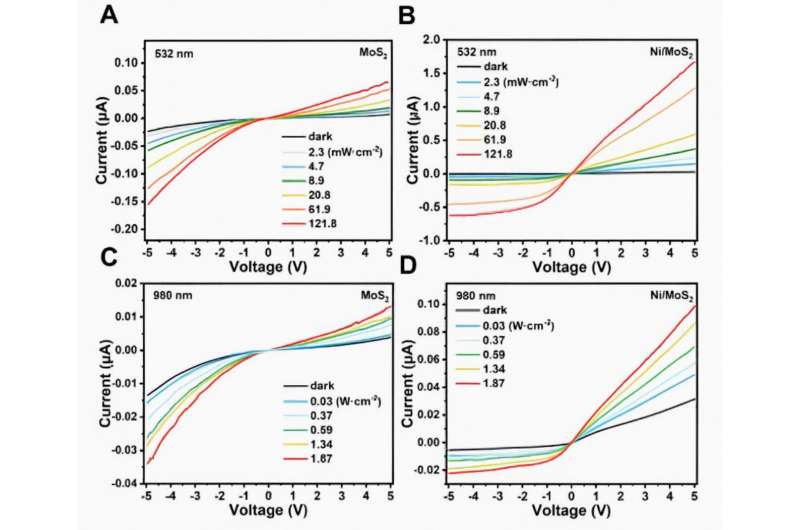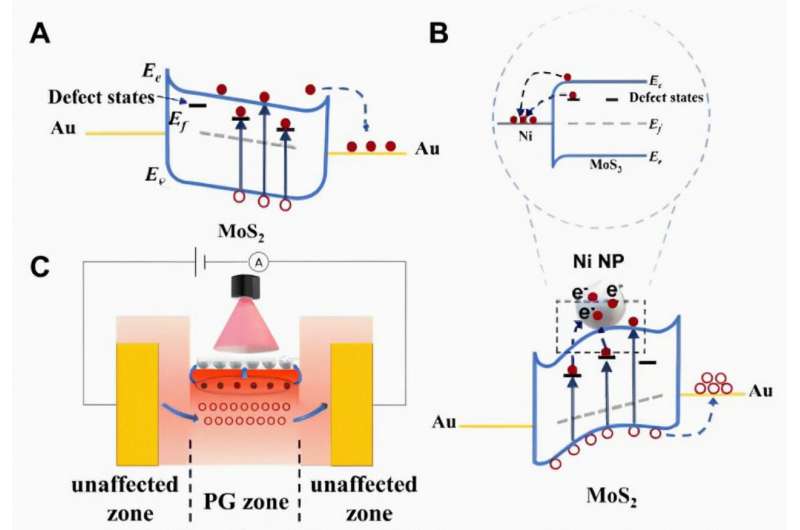This article has been reviewed according to Science X's editorial process and policies. Editors have highlighted the following attributes while ensuring the content's credibility:
fact-checked
peer-reviewed publication
proofread
High-performance MoS₂-based infrared photodetector induced by the photogating effect

Recently, Professor Qi Weihong of Northwestern Polytechnical University and Academician Liu Weimin of Lanzhou Institute of Chemical Physics, Chinese Academy of Sciences, found that nickel nanoparticle-modified defective molybdenum disulfide can form a photogating effect, which can greatly improve the infrared photodetection performance of the device.
This discovery can be used to reveal the carrier transport characteristics of heterojunctions formed by metal nanoparticles and semiconductors without surface plasmon resonance effects. The work is published in the journal Research as "A High Performance MoS2-Based Visible-Near Infrared Photodetector from Gateless Photogating Effect induced by Nickel Nanoparticles."
Photodetectors are widely used in environmental monitoring, remote sensing and biomedical imaging. Molybdenum disulfide (MoS2) is a representative 2D transition metal dichalcogenide that exhibits many appealing properties, making MoS2 a promising candidate for next-generation optoelectronic devices. However, the relatively large bandgap of MoS2 limits its optoelectronic applications in the NIR regime.
Defect engineering, such as introducing S vacancies, provides promising insight into designing MoS2-based devices with broadband photodetection.
However, there is a bottleneck in that the defect level introduced by S vacancies leads to photogenerated carriers being easily trapped by defect states, which induce a slow response speed and poor sensitivity, thus damaging the performance. After Ni nanoparticle decoration, the responsivity and detectivity of the photodetector increase from 0.15 A·W-1 and 1.1×109 Jones to 1.38 A·W-1 and 8.9×109 Jones.
S vacancies and Ni NPs were simultaneously introduced into multilayer MoS2 by hydrogen reduction in a tube oven with a flow of Ar/H2 (95%/5%). In addition, a multilayer MoS2 crystal annealed in a reducing atmosphere without Ni nanoparticles was used as a contrast. The disparate current-voltage (I-V) characteristics of the as-fabricated photodetector (Ni/MoS2) and contrast photodetector (MoS2) under dark and illuminated conditions.

Electrons were the majority in the MoS2 device, while holes were the majority in the Ni/MoS2 device. The Ni/MoS2 device exhibited a highly improved photocurrent, while the dark current stayed almost constant.
The effects of Ni nanoparticles were revealed based on the energy band structure diagrams presented. After the decoration of Ni nanoparticles, MoS2 and Ni formed a built-in electric field, making electrons flow into the Ni NPs, namely, the photovoltaic effect. The electrons flowing into Ni nanoparticles would lead to the depletion of electrons in MoS2 and a photogating effect (gate voltage<0) to enhance the conductance in the channel and avoid the adverse impact of defect levels.
In addition, the Ni/MoS2 device could reach an equilibrium state more easily with the electrons flowing into the Ni nanoparticles since this behavior greatly reduced the recombination at defect levels trapping the electrons.
This study proposes an effective strategy to optimize defect engineering. Defect engineering can broaden the photodetection range of MoS2, especially in the infrared regime. Addressing the issues of defect engineering can promote the applications of MoS2 for infrared photodetectors. This strategy provides a creative strategy to avoid the adverse impacts of defect engineering when defect levels are introduced to reduce the bandgap.
The electrons accumulate in Ni nanoparticles, which leads to the depletion of electrons and the photogating effect. Therefore, Ni nanoparticle decoration enables a faster response speed and an improvement in the performance of the photodetector. In the authors' opinion, this strategy and the corresponding mechanism can provide new insight into designing photodetectors and a reference for research on similar systems.
The study was published in Research. Dr. Weihong Qi is a full professor in materials science, mainly engaged in research on two-dimensional materials and computational materials. Professor Weimin Liu is a member of the Chinese Academy of Sciences and a fellow of The World Academy of Sciences (TWAS). His research interests include lubricating materials and space tribology. Currently, he takes the duties of Co-Editors-in-Chief of Tribology International and Chief Editor of Chinese Journal of Tribology.
More information: Ran Duan et al, A High-Performance MoS2 -Based Visible–Near-Infrared Photodetector from Gateless Photogating Effect Induced by Nickel Nanoparticles, Research (2023). DOI: 10.34133/research.0195
Journal information: Research
Provided by Research





















